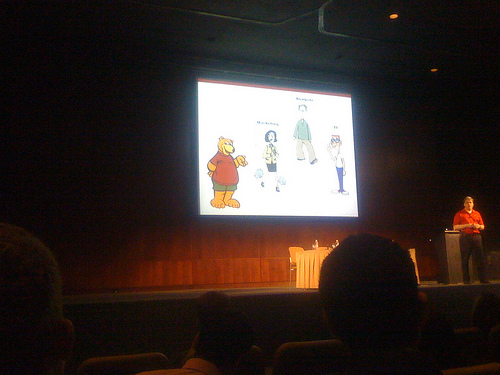Infopresse 360 Day on Web Analytics: WA Hard by Stéphane Hamel?
As part of the infopresse conference on Web Analytics, Stéphane Hamel gave us a presentation that fits into a recent debate among the main players in the field, is web analytics difficult? Through a colorful and comical presentation, he showed us ways to make this discipline easier.
“ Web Analytics Hard? is a direct response to Eric Peterson 's recent statement that web analytics is a difficult discipline. On this issue, Stéphane Hamel followed suit with Avinash Kaushik to defend the clan of web analytics is easy.
Here are some ways to make it easier. After introducing us to the persona that represents him – a big teddy bear – Stéphane tells us the reasons that lead us to think that Web Analytics is difficult. He gives us the analogy of accountants who keep the books to ensure that the accounts are properly kept. This role of the accountant should exist in web analytics and yet, it is very rare to see a dedicated resource in organizations today.

In an ideal world, an organization that wants to get into the field should perform certain tasks, such as comparing itself to the competition, looking at the marketing plan and listening to the “Voice Of Customer” in order to make informed decisions.
Stéphane uses Kaushik's image to express that in reality, it is the HIPPOs who make the final decisions. HIPPO? Highest Paid Person's Opinion – you get the picture.
He then quotes us the explanation he gave to his mother-in-law to express in simple words what web analytics is all about: when he cooks a roast beef, he may follow the instructions to the letter, in the end , the roast beef is overcooked. To remedy the situation, he equipped himself with a tool: the thermometer, which allows him to measure the appropriate temperature. In conclusion, there is no magic recipe for success online, so you have to equip yourself to measure what is happening on the site.
Another problem in organizations is the lack of time and resources:
- Marketing is overwhelmed and does not control what happens on the site. The solution?
- Marketing turns to an analyst. In turn, the analyst is sorely lacking in data on the site and turns to IT.
- Finally, IT, which already has a pile of projects and bugs to fix, adds the analyst's requests to the bottom of the list.
The second part of Stéphane Hamel's presentation is dedicated to the presentation of 8 criteria or factors to be respected to make this work easier.
What to do to make it easier?
1 – Determine your level of maturity to set a specific short-term maturity objective:
- level 1: feel good information, basic statistics
- level 2: behavior analysis – conversion funnels, definition of a dashboard, establishment of KPIs, A/B tests.
- level 3: optimization of marketing activities – effective integration of personas in measurement, segmentation, SEO measurement and optimization, campaign optimization, KPI alerts.
- level 4: multi-channel integration – CRM integration, personalization of navigation according to behavior, 330 degree view of the customer (we exclude 30 degrees for privacy!)
- level 5: nirvana, we are no longer talking about web analytics but simply ANALYTICS. There, the organization measures online and offline behavior, and allows continuity between the two until conversion off or on the web.
2 – Consider the Trinity, a concept borrowed from Avinah Kaushik
Understand the customer's experience, to influence their behavior and put effort into making it easier for the customer online.
3- Always put data in context – Multiplicity (another borrowing from Kaushik)
My visits are increasing, why? A promotion in progress, an economic context, …
4- Having a team up to the task
The challenge, combining the following three fields of expertise: business, analysis and technology
5- Have an approach that measures the results, not the means taken to achieve the results.
For example, launch a contest campaign: rather than measuring registrations, measure the objective of the campaign and the direct impact for the company.
6- Define relevant KPIs.
Set SMART goals: simple, measurable, achievable, realistic, on time.
7- Define a process
Continuous improvement – Six Sigmas:
Define – Measure – Analyze – Improve – Control
8- Finding the right tools
According to him, this is the last thing to worry about. If all the other steps have been well defined, the choice of tool becomes simple.
Stéphane's presentation is available directly on his blog immeria .
A summary of the other conferences of the day are also available:
- Jacques Warren's conference
- Avinash Kaushik's lecture
- The Via Rail and RDS (Branchez-vous) case study

-1.png)
-1.png)






